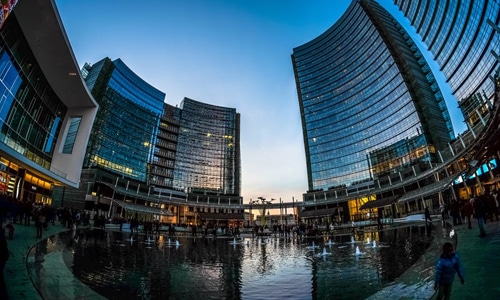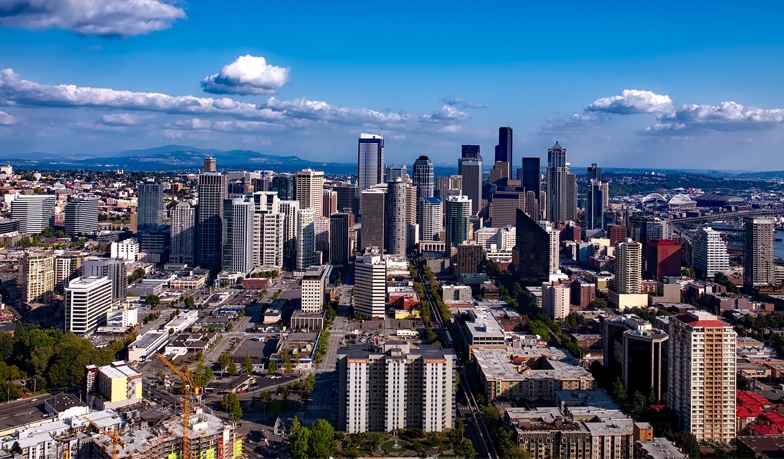As the name suggests, Aerial Photography defines the process of capturing pictures above the ground, or while in the air. These types of photos have numerous uses and applications across a plethora of research fields, artistic photography and touristic purposes. Aerial photography has gradually cemented its importance not just for its beauty and usefulness, but also for its significance in helping us interpret, discover and map out the world as we know it.
But precisely what does it entail? What does it mean and what are the various essential tips and components that define it? To understand this and more, kindly read on.
HISTORY OF AERIAL PHOTOGRAPHY
Rising into popularity right after the famous 1906 Chicago earthquake, aerial photography has gradually become an essential aspect of everyday living with applications spreading far and wide to include use in archeology, landscapes studies, environmental changes, and documentation and map compilations. Its usefulness and ability to clarify fine details have seen it find use and popularity not just for professional usage, but also for rookie photography enthusiasts who practice it by use of drones.
(Source: OldFliersGroup)
TYPES OF AERIAL PHOTOGRAPHS
Oblique Photographs
Oblique photographs simply represent aerial photos taken at an angle. They can either be low or high and close-up or wide.
True Vertical Photographs
As opposed to oblique pictures, these types of pictures are those directly taken from the object of interest. This kind of photography requires special equipment especially since they need to be taken at a precise angle of 900 just above the item to be captured, with a slight but accurate variation of up to 30.
True vertical photographs are vital since they are used in the calculation of distance and for mapping.
Also, there are vertical photographs that are slightly more accurate than true vertical photographs referred to as ortho-rectified photographs (vertical). These are vertical photographs that are edited to eradicate any distortions.
Near Vertical Photographs
These pictures are a cross between oblique photographs and true vertical ones. They are not as precise and accurate as true vertical photographs, but they are close to being so.
Taking near vertical photographs does not require the use of special cameras, as is the case with true vertical photographs. However, special aircraft with pods is necessary to take these photos.
Wide Photographs

To define a photograph as comprehensive or not, it is essential for you to sift through the object of the photography. Extensive pictures are those types of photos that include the entire surrounding of the object in the picture. The use of Wide photographs is essential, especially when capturing a significant area space such as for planning applications or such.
In the same case, you may find photographs which are remarkably wider than the standard’ wide. They are called Panorama images. The exciting thing about Panorama images is that at times, they are impossible to capture using a typical camera. As such, they are stitched together by use of computer programs.
Close Ups
Unlike extensive photographs, close-up photographs do not include the surroundings, and the primary focus of these pictures is the object of photography. With these types of photos, one can capture fine details of the purpose of photography.
Ideally, these types of shots ought to fill the frame of the image in question. At times, these pictures are magnified to cover the structure entirely. And while this could slightly interfere with the quality of the image, it depends on whether the size is indeed the priority in which case it is appropriate.
High Photographs
These types of photographs are those which are inclusive of the horizon.
Low Photographs
Unsurprisingly, low photographs represent shots that do not include the background alongside the primary image.
TIPS FOR SUCCESSFUL AERIAL PHOTOGRAPHY
For most of us, Photography has over the years been a traditional way of life. Not only has it worked wonders in helping us tell our stories; it has also served a significant part in helping us capture the world in a whole new perspective.
The most accepted and most popular way of taking pictures is y use of camera and from the ground-sometimes with a little twist such as doing it from a raised platform or making use of an elevation like a hill.
However, the most outstanding pictures are those taken from the air above (aerial photography) as is commonly referred to. Common perception places this type of photography as an artistic skill which when mastered can produce the most exquisite photo shots.
Aside from giving remarkable locations only shot from above, aerial photography also offers an extensive panoramic view of the overall broad sky.
While in the air-either in a helicopter or a light flight-you have an unlimited view and you can enjoy a 180-degree horizon stretch allowing you to capture all the exciting aspects of nature surrounding you. Nonetheless, as easy and fun as it sounds, catching aerial shots mandates for more than just having a camera and taking a shot. It goes beyond conventional ground photography. If you genuinely wish to learn about this art, here are some few things you ought to know to have a successful aerial photography experience.
Proper shooting environment
First and foremost even before you can set out for the skies, you need to be well aware of the prevailing weather conditions. Ensure there is sufficient ambient light (readily available natural light on the photo shooting scene). By shooting with ambient light allows you to preserve the scene’s atmosphere which is a delight for numerous photographers.
The recommended time during the day to take the best aerial photography is either during the last or first hour of the day. Why? At these times, the angle of the sun inspires shadows which can correctly define the shapes of several features as in the picture.
Proper planning
The success of any project and not just aerial photography begins with proper planning. Every decision that you make will subsequently influence how successful your en project turns out. The first choice that you need to make is what type of aircraft best suits your needs. For instance, if you are looking to shoot scenes in a rural setting, you need to take your pictures from a typically fixed-wing aircraft such as the Cessna 152 since it can cover significant ground. For urban environments, the better option is to choose a helicopter. Shooting from helicopters produces good shots.
What’s more, you need to check out the official website of your preferred tour to look out for customer reviews to get a proper insight of your preferred scene to identify whether it fulfills your demands.
Airplane windows
When conducting your aerial photography venture, be sure to avoid taking photographs via unopened windows completely. This is because windows are made using Plexiglas, and as such no matter how clean they appear, or polished they are, they still create reflections which you may not identify while in the air.
Appropriate flying crew
While getting a qualified pilot to fly you over the scenes and objects you want to take photos of is the first step, it does not, however, cut it. You need to get a pilot who can fly steadily over the target object to give you an excellent glimpse of taking a shot. What’s’ more, you need to go with a pilot who you can efficiently communicate with since you will need him/her to not only fly actively but also do so while constantly yawing, pitching and banking the aircraft. This will give you an advantage and allow you to capture clear shots.
Arrive on time at the FBO (Fixed Based on Operation)
Early arrival at the FBO located at the airport is essential for a successful aerial photography session. Be sure to be there at least half an hour earlier since this will afford you ample time to interact with your pilot about your plan so that you can be in unison before takeoff. In reality, not all pilots have previously worked with aerial photographers and as such may need prepping just to understand your mission’s exclusivity.
You also get ample time to simulate how you will operate your camera just before you do the real thing.
Carry the right equipment
In your attempts to capture the best possible experience aerial photography can inspire, it is essential that you use the recommended equipment to get the most beautiful shots with each click of your camera.
First, be sure to carry with you the recommended cameras together with the necessary zoom lenses-either designed for shooting aerial videos or aerial photography. Other than zoom lenses, ensure you also make use of the fastest shutter speed since this is what inspires the sharpness of your photos.
MODERN APPLICATIONS OF AERIAL PHOTOGRAPHY
As the history of aerial photography outlines, this art slowly spread from the military and gradually asserted its dominance in the civilian world-particularly for enthusiast photographers looking to quench their thirst for adventure and discovery. There are several conventional aerial photography applications, and some of the crucial ones include:
1. Archeology

The process of capturing shots from high above the ground has worked exceptionally well for archeologists who have been able to locate previously lost monument, discover hidden sites and treasures not accessible from the field or buried under water, sand or soil, and even track features of sites not quite visible from ground level. What’s more, they can explicitly map everything that surrounds a location of interest, not to mention recording hidden, unsafe or remote areas across the globe.
Crop marks, parch marks or soil marks are some of the best examples of precisely what aerial photography can help achieve having been able to document human culture, history, and even development.
2. Real Estate and Urban Studies
Aerial photography has over the years been a fundamental contributor to various urban studies fields such as sociology, landscape studies, geography, urbanism, architecture, and mapping. For instance, low-level type of aerial design is utilized in studying the resulting impact of the introduction of new structures at a given urban landscape, explore economic and social changes and to research the existing infrastructure concerning the presentation and development of new urban projects.
As for real estate, any individual that makes use of this technology creates a competitive edge since they can clearly and better demonstrate the beauty and or value of their property with clear and comprehensive pictures.
3. Climate Change and Environmentalism
The unprecedented changes in the environment and the climate which are affecting everyone on the planet are now comprehensively getting documented through aerial photography. Researchers use aerial photography to examine the overall impact of characteristic changes in the climate over several ecosystems such as lake drying, water expansion and the reduction of forest area. What’s more, it also assists researchers in conducting forensic investigations on the environment and subsequently monitor every change in the environment whether it is documentation of invasive species or modification of landscapes among others.
4. Tourism
Think of that amazing photo of the Eifel Tower or the Egyptian pyramids. In between that fantastic shot is an aerial photograph blended with typical ground level pictures. Aerial photography gives a broader perceptive of an object. Although we all adore standard panoramic photos of an exotic island complemented by a dreamlike sunset, we also cannot deny the breathtaking sight of a calm blue lagoon or an unending green pasture.
5. Art
Getting a stunning location and subsequently capturing it both from a precise angle with the advantage of the apt time of the day can instantly transform a photo into a masterpiece which necessarily doesn’t need to for a commercial, scientific or promotional purpose.
Artistic photographers are renowned for experimenting different creative ways of immortalizing the world’s aesthetic characteristic, and what better way to do it than use aerial photography. Among the most iconic projects inspired by aerial photography are projects created by Alexander Heilner reputed for his excellent ability to instantly transform a dull landscape into nothing short of an abstract painting.
AERIAL PHOTOGRAPHY PRACTICE AND KNOW-HOW
While many consider aerial photography to be only about having a good camera and taking the best shots while well above the ground on an aircraft, professional photographers know that it goes beyond. For an aspiring aerial photographer, you need to first consult detailed and comprehensive guides on the art of aerial photography. Some of the basic facts that you should know and keep in mind include:
- Select a suitable delivery means: this can either be a drone, helicopter or plan and depending on your choice, you need to also subsequently adapt both your photography skills and gear to capture relevant and breathtaking photos.
- Select the most appropriate day/month/year concerning seasons and weather conditions.
- Choose the best time of the day. When taking aerial photographs, it is essential you orient your project depending on the overall position of the sun in the sky. Also, you also need to consider the best night time for night aerial photography.
- Carefully select your gear-Be very considerate of your optics, custom parameters, and manual nodes, instances of camera shakes, image composition, absence or presence of gimbal together with the additional equipment necessary and essential for your project.
- Other factors you also need to consider and keep in mind include flight time, safety regulations, necessary legislation and even health precautions among others.
SUMMARY:
For anyone that fancies the art of Aerial photography, you need to know that it calls for a lot of practice. Nonetheless, while it seems like a bundle of fun and exceptional art, to capture remarkable photos, you need to keep in mind all the factors, considerations and tips as outlined in this article while also doing your research. If you can master each of these particular details, then you can enjoy a whole new perspective courtesy of this type of photography.

